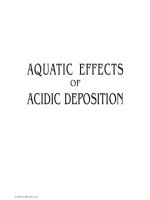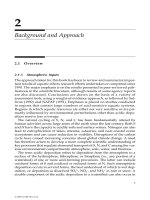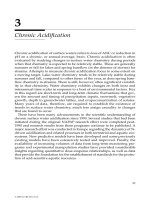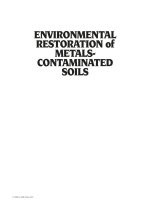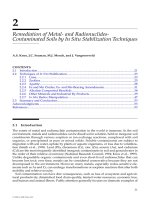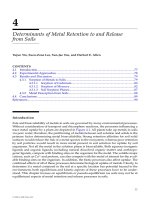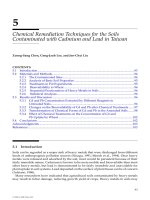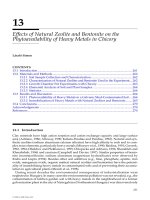Phsicochemical Treatment of Hazardous Wastes - Chapter 1 potx
Bạn đang xem bản rút gọn của tài liệu. Xem và tải ngay bản đầy đủ của tài liệu tại đây (841.47 KB, 41 trang )
CRC PRESS
Boca Raton London New York Washington, D.C.
Physicochemical
Treatment of
Hazardous
Wastes
WALTER Z. TANG
This book contains information obtained from authentic and highly regarded sources. Reprinted material
is quoted with permission, and sources are indicated. A wide variety of references are listed. Reasonable
efforts have been made to publish reliable data and information, but the author and the publisher cannot
assume responsibility for the validity of all materials or for the consequences of their use.
Neither this book nor any part may be reproduced or transmitted in any form or by any means, electronic
or mechanical, including photocopying, microfilming, and recording, or by any information storage or
retrieval system, without prior permission in writing from the publisher.
The consent of CRC Press LLC does not extend to copying for general distribution, for promotion, for
creating new works, or for resale. Specific permission must be obtained in writing from CRC Press LLC
for such copying.
Direct all inquiries to CRC Press LLC, 2000 N.W. Corporate Blvd., Boca Raton, Florida 33431.
Trademark Notice:
Product or corporate names may be trademarks or registered trademarks, and are
used only for identification and explanation, without intent to infringe.
Visit the CRC Press Web site at www.crcpress.com
© 2004 by CRC Press LLC
Lewis Publishers is an imprint of CRC Press LLC
No claim to original U.S. Government works
International Standard Book Number 1-56676-927-2
Library of Congress Card Number 2003055435
Printed in the United States of America 1 2 3 4 5 6 7 8 9 0
Printed on acid-free paper
Library of Congress Cataloging-in-Publication Data
Tang, Walter Z.
Physicochemical treatment of hazardous wastes / Walter Z. Tang
p. cm.
Includes bibliographical references and index.
ISBN 1-56676-927-2 (alk. paper)
1. Hazardous wastes—Purification. I. Title.
TD1060.T35 2003
628.4
′
2—dc21 2003055435
TX69272_C00.fm Page 2 Wednesday, November 19, 2003 1:21 PM
© 2004 by CRC Press LLC
Dedication
In memory of my father, Yuxiang Tang
To my mother, Yongcui Hu, and
To my children, William and Elizabeth,
with love.
TX69272_C00.fm Page 3 Wednesday, November 19, 2003 1:21 PM
© 2004 by CRC Press LLC
Preface
On average, one ton of hazardous waste per person is generated annually
by industries in the United States. Before the Resource Conservation and
Recovery Act of 1984, hazardous wastes were improperly disposed of into
the environment without any regulation. As a result, remediation of these
contaminated sites and management of the ongoing hazardous waste sources
are two major tasks to be achieved by treatment technologies. Due to the
complex nature of the contaminated media and of the pollutants, environ-
mental professionals are facing a host of questions, such as: What are the
contaminated media? What is the nature of the pollutants? What are the
concentrations of each pollutant? Among biological, physicochemical, or
thermal technologies, if physicochemical processes are to be the solution, the
treatability of various pollutants must be assessed before a process can be
properly designed. This book systematically examines the treatability of
hazardous wastes by various physicochemical treatment processes according
to the Quantitative Structure–Activity Relationships (QSARs) between
kinetic rate constants and molecular descriptors.
I have attempted to achieve five major goals in this book: (1) fundamental
theories of thermokinetics such as the transition state theory are used to
integrate research findings in Advanced Oxidation Process (AOP) research;
(2) reaction kinetics and mechanisms for each AOP are explained in terms
of elementary reactions and the reactive center; (3) QSARs are introduced
as methodologies to assess the treatability of organic compounds; (4) com-
putational molecular descriptors such as the
E
HOMO
and
E
LUMO
are used
extensively in the QSAR analysis; (5) the kinetics of various AOPs are com-
pared so that the most effective process can be selected for a given class of
organic pollutants.
This book is divided into five parts. Chapter 1 to Chapter 4 define the
hazardous waste problems and physicochemical approaches to solve these
problems. Chapter 5 explains QSAR theory and its application to predicting
molecular descriptors and hydroxyl radical reactions. Chapter 6 to Chapter
12 focus on each of the eight most important AOPs. Chapter 13 presents a
major reductive treatment technology, zero-valence iron, and Chapter 14
compares each AOP according to its oxidation kinetics for specific classes of
organic compounds. Each chapter begins with an introduction of the process
and its historical development. The intention is to demonstrate how funda-
mental sciences guide the search for these innovative technologies. Also,
such introductions provide the information necessary for readers to delve
into the literature for current research topics. Then, the principles of the
process and the degradation kinetics, along with mechanisms of organic
TX69272_C00.fm Page 5 Wednesday, November 19, 2003 1:21 PM
© 2004 by CRC Press LLC
pollutants are explained in terms of elementary reactions. These elementary
reactions not only are important in assessing the treatability of organic pol-
lutants using QSAR but are also critical in properly designing AOP processes.
Finally, QSAR models are discussed to demonstrate the effect of molecular
structure on their degradation kinetics and to rank the treatability of each
organic compound.
This book is intended for graduates, engineers, and scientists affiliated
with universities, consulting firms, or national laboratories and who are
dealing with the remediation of hazardous wastes in water, groundwater,
and industrial wastewater. Due to the in-depth discussion of organic chem-
istry, graduate students in environmental engineering and upper-level
undergraduates in chemistry, chemical engineering, or environmental sci-
ences who intend to enter environmental engineering should find it useful
in their professional development. Students will learn a systematic approach
to applying various sciences to the search for effective treatment technologies
in terms of thermokinetic principles. Engineers will find the QSAR models
extremely useful in selecting treatment processes for hazardous wastes
according to the molecular structures of organic pollutants. Scientists in
industrial and governmental laboratories, as well as designers and reviewers
in remediation projects, will also find the book helpful in their efforts to
restore our environment and keep it clean.
During the 1970s, the U.S. Environmental Protection Agency designated
phase-transfer technologies such as air stripping and activated carbon
adsorption as the best available technologies. The search for mineralizing
organic pollutants shifted the focus from phase-transfer technologies to oxi-
dative technologies after the Hazardous Waste Amendment in 1984. As a
result, AOPs were developed in laboratories, extended to pilot sites, and
finally applied in the field from the 1980s to the present. The concept of an
AOP includes any process that uses hydroxyl radicals as the predominant
species; however, the concept failed to provide fundamental theories such
as transition state theory to guide research communities in their search for
the most effective oxidation processes. In a strict sense, then, AOP should
be defined as a Catalytic Oxidation Process (COP), which would provide
sound scientific footing for the search for innovative technologies. It is well
documented that oxidants such as oxygen, ozone, and hydrogen peroxide
oxidize organic pollutants slowly. It is only when they are catalytically
decomposed into other active species such as hydroxyl radicals that the
activation barrier of the activated complex can be significantly lowered. The
catalysts normally used are ultraviolet photons, transition metals or their
ions, ultrasound, and electrons. Increasing temperature and pressure can
further enhance the catalytic effect.
My research on AOPs began over 12 years ago at the University of Dela-
ware. When I worked on the degradation of phenols by a visible photon/
CdS system, I had to wake up at midnight in order to take samples from a
photocatalytic reactor because the reaction half time in degrading 0.001-
M
phenol is about 1 day. After I found that Fenton’s reagent was an extremely
TX69272_C00.fm Page 6 Wednesday, November 19, 2003 1:21 PM
© 2004 by CRC Press LLC
fast process, I added hydrogen peroxide and ferrous ion separately to the
reactor. The reaction half time reduced from one day to a few hours. When
I added hydrogen peroxide first and then the ferrous sulfate, the reaction
half time was reduced to a few minutes. It became clear to me during my
investigation of the oxidation kinetics and mechanisms of chlorinated phe-
nols by Fenton’s reagent that the efficiency of AOPs depends upon both the
rate and the amount of hydroxyl radical generated and the molecular struc-
ture of organic compounds.
It has long been recognized that the treatability of different classes of
organic compounds differs significantly. Furthermore, the treatability of
chlorinated compounds within a given class of organic pollutants decreases
as the chlorine content in a molecule increases. Indeed, the carbon in tetra-
chloride has been oxidized by chlorine so much that it is even insensitive to
hydroxyl radical attack. Therefore, elementary iron may be a more econom-
ical way to reduce these pollutants rather than to oxidize them. To quantify
the effect of chlorine, QSAR models are used to assess the effect of chlorine
on molecular descriptors such as
E
HOMO
and
E
LUMO
. The treatability of organic
compounds by each AOP, then, can be evaluated using QSAR models of the
oxidation kinetic rate constants and molecular descriptors.
Thermokinetics, group theory, and computational QSARs should find
broad application in future research effort on AOPs for several reasons: (1)
thermokinetics bridges thermodynamics and kinetics, which serve as the
foundation for QSAR analysis; (2) group theory may offer kinetic calculations
of activated complex for a given class of compounds, and the resulting
degradation rate constants can be more accurately estimated; and (3) as more
data regarding operational costs become available for each technology,
QSARs may be incorporated into the calculations to estimate the operational
cost of a specific compound. In addition, nanotechnology will become
another research focus in the next decade to develop nanoparticles such as
elementary iron, TiO
2
, nanofiltration, and electromembranes in the physico-
chemical treatment of hazardous wastes.
TX69272_C00.fm Page 7 Wednesday, November 19, 2003 1:21 PM
© 2004 by CRC Press LLC
About the Author
Walter Z. Tang
(B.S., Sanitary Engineering,
Chongqing University, Chongqing, China, 1983;
M.S., Environmental Engineering, Tsinghua Uni-
versity, Beijing, China, 1986; M.S., Environmental
Engineering, University of Missouri-Rolla, 1988;
Ph.D., Environmental Engineering, University of
Delaware, 1993) is an Associate Professor and
Graduate Director for Environmental Engineering
in the Department of Civil and Environmental
Engineering at Florida International University
(FIU), Miami, FL. He has been a registered Profes-
sional Engineer in Florida since 1993. Dr. Tang has had extensive research
experience over the past 14 years in the area of physicochemical treatment
processes; environmental applications of aquatic, organic, catalytic, and col-
loidal chemistry; advanced oxidation processes; environmental molecular
structure–activity relationships (QSARs); and methodology in environmen-
tal impact assessment.
Dr. Tang is the principal investigator for 14 research projects supported by
the U.S. Environmental Protection Agency, the National Institutes of Health,
and the National Science Foundation. He has published 24 peer-reviewed
papers and 41 conference papers, co-authored one book, and contributed
one chapter to a book. Also, he has written graduate teaching manuals for
three different graduate courses. He has been a referee for 12 journals and
has served as a proposal reviewer for the NSF and the National Research
Council. Dr. Tang has organized and presided over 11 sessions at various
national and international conferences on advanced oxidation processes
(AOPs) and was the invited speaker at Florida Atlantic University in 2001.
Dr. Tang has supervised three post doctors, three visiting professors, and
35 graduate students in environmental engineering, and he has taught six
undergraduate courses and nine graduate courses in the Department of Civil
and Environmental Engineering at FIU. Dr. Tang received FIU’s Faculty
Research Award in 1997, Faculty Teaching Award in 1998, and Departmental
Teacher of the Year Award in 1998. He is a member of Chi Epsilon and is
listed in
Who’s Who in the World
,
Who’s Who in America
,
Who’s Who in Science
and Engineering
, and
Who’s Who Among America’s Teacher
s.
Since 1994, Dr. Tang has been a co-principal investigator in joint research
projects on AOPs with professors at Tsinghua University, Chongqing Uni-
versity, and the Third Medical University of Chinese Military in Chongqing,
China. As a research fellow in the China–Cornell Fellowship Program
TX69272_C00.fm Page 9 Wednesday, November 19, 2003 1:21 PM
© 2004 by CRC Press LLC
supported by the Rockefeller Foundation, Dr. Tang offered six seminars at
Tsinghua University. As a co-principal investigator from 1998 to 2002 of the
Two-Bases Program sponsored by the China National Science Foundation,
he advised a Ph.D. student at Tsinghua University on his dissertation: QSARs
in the Anaerobic Degradability of Organic Pollutants. Chongqing University
and Chongqing Jianzhu University granted the visiting professorship to Dr.
Tang in 1999. He won six joint research projects sponsored by the Chinese
Ministry of Education for Chongqing University. He was the invited speaker
at Nankai University and Gansu Industry University in 2002 and at Wuhan
University in 2003. He was named the Outstanding Chinese Scholar in the
southern region of the United States and served as a Foreign Expert in the
State Sunshine Program of China. The Chinese Ministry of Education invited
Dr. Tang to Beijing as a state guest for the 50th anniversary of China National
Day in 1999.
TX69272_C00.fm Page 10 Wednesday, November 19, 2003 1:21 PM
© 2004 by CRC Press LLC
Acknowledgments
I would like to acknowledge the contributions to this book made by my
former graduate students: Tzai-Shian Jung, Angela Pierotti, Sangeeta
Dulashia, Todd Hendrix, Ricardo Martinez, Lucero Vaca, Stephanie Tassos,
Rena Chen, Taweeporn Fongtong, Jiun-Jia Hsu, Kenneth Morris, Jose Polar,
Carlos Hernandez, and Jeffrey Czajkowski. I thank Jiashun Huang, Dennis
Maddox, and Pia Hansson Nunoo for their many hours devoted to typing
and drawing of the figures. I would like to thank all the students since 1991
at Florida International University (FIU) who took the graduate course,
Advanced Treatment System, upon which the book is based. Students who
assisted in this book include Bernine Khan, Lillian Costa-Mayoral, Christo-
pher Wilson, and Oscar Carmona. A special acknowledgment goes to Geor-
gio Tachiev of the Hemisphere Center for Environmental Technology at FIU
for his constructive proofreading.
I am grateful to Dr. C.P. Huang at the University of Delaware for intro-
ducing me to the research of AOPs. Many QSAR models were developed
through financial support from the U.S. Environmental Protection Agency,
National Science Foundation, and National Institutes of Health, and their
support is greatly appreciated. Thanks go to Mrs. Virginia Broadway at the
USEPA for supporting and administrating five EPA fellowships to my stu-
dents over the last decade. Dr. William Cooper and his colleagues are
acknowledged for their work on high-energy electron beams. I would like
to thank Dean Vish Prasad and Associate Dean David Shen of the College
of Engineering at FIU for allowing me to complete the book. I am in debt to
Gail Renard and Sara Kreisman, my book editors at CRC Press LLC, who
provided excellent professional guidance and spent numerous days editing
and proofreading the manuscript.
TX69272_C00.fm Page 11 Wednesday, November 19, 2003 1:21 PM
© 2004 by CRC Press LLC
Table of Contents
Chapter 1
Environmental Laws
1.1 Introduction
1.2 Environmental Laws
1.2.1 National Environmental Policy Act (NEPA)
1.2.2 Occupational Safety and Health Act (OSHA)
1.2.3 Clean Water Act (CWA)
1.2.4 Safe Drinking Water Act (SDWA)
1.2.5 Toxic Substances Control Act (TSCA)
1.2.6 Resource Conservation and Recovery Act (RCRA)
1.2.7 Hazardous and Solid Waste Amendments (HSWA)
1.2.7.1 Comprehensive Environmental Response,
Compensation and Liability Act (CERCLA)
1.2.7.2 Superfund Amendments Reauthorization Act
(SARA)
1.2.7.3 Clean Air Act (CAA)
1.3 Summary
References
Chapter 2
Environmental Hazardous Wastes
2.1 Introduction
2.2 Classification of Hazardous Pollutants
2.3 Sources of Hazardous Waste
2.4 Contaminated Media of Hazardous Wastes
2.4.1 Groundwater
2.4.2 Soil
2.4.3 Air
2.4.4 Sludge and Sediments
2.5 Distribution of Hazardous Pollutants in Contaminated Sites
2.5.1 National Priorities List Sites
2.5.1.1 Contaminants
2.5.2 Resource Conservation and Recovery Act
2.5.2.1 Contaminated Media
2.5.2.2 Contaminants
2.5.3 Underground Storage Tanks Sites
2.5.3.1 Contaminated Media
2.5.3.2 Contaminants
2.5.4 Department of Defense
2.5.4.1 Contaminated Media
TX69272_bookTOC.fm Page 13 Thursday, November 20, 2003 10:55 AM
© 2004 by CRC Press LLC
2.5.4.2 Contaminants
2.5.5 Department of Energy
2.5.5.1 Contaminants
2.5.6 Waste Sites Managed by Other Federal Agencies
2.5.6.1 Contaminated Media
2.5.6.2 Contaminants
2.5.7 Sites Managed by States and Private Companies
2.5.7.1 Contaminated Media
2.5.7.2 Contaminants
2.6 Conclusion
References
Chapter 3
Physicochemical Treatment Processes
3.1 Introduction
3.2 Treatment Technologies
3.2.1 Phase Transfer Technologies for Halogenated VOCs and
Nonhalogenated VOCs
3.2.1.1 Air Stripping
3.2.1.2 Soil Vapor Extraction (SVE)
3.2.2 Phase Transfer Technologies for Halogenated SVOCs,
Nonhalogenated SVOCs, and Non-VOCs
3.2.2.1 Activated Carbon Adsorption
3.2.2.2 Soil Washing
3.2.3 Thermal Treatment Processes
3.2.3.1 Thermal Desorption
3.2.3.2 Dehalogenation at High Temperature
3.2.3.3 Incineration
3.2.4 Solidification/Stabilization (Vitrification)
3.2.5 Advanced Oxidation Processes (AOPs)
3.3 Established Treatment Technologies and Their Markets
3.3.1 National Priorities List Sites
3.3.1.1 Remedial Technology
3.3.1.2 Remediation Cost
3.3.2 Resource Conservation and Recovery Act
3.3.2.1 Remedial Technologies
3.3.2.2 Remedial Cost
3.3.3 Underground Storage Tank Sites
3.3.3.1 Remedial Technology
3.3.4 Department of Defense
3.3.4.1 Remedial Technology
3.3.4.2 Remedial Cost
3.3.5 Department of Energy
3.3.5.1 Remedial Technology
3.3.5.2 Remedial Cost
3.3.6 Waste Sites Managed by Other Federal Agencies
TX69272_bookTOC.fm Page 14 Thursday, November 20, 2003 10:55 AM
© 2004 by CRC Press LLC
3.3.6.1 Remedial Technology
3.3.6.2 Remedial Cost
3.3.7 Sites Managed by States and Private Parties
3.3.7.1 Remedial Technology
3.3.7.2 Remedial Cost
3.4 How to Select Treatment Technology
3.4.1 Nature of Pollutants
3.4.2 Concentration of Pollutants
3.4.3 Contaminated Media
3.5 Summary
References
Chapter 4
Advanced Oxidation Processes
4.1 Introduction
4.2 Chemical Kinetics
4.2.1 Zero-Order Reactions
4.2.2 First-Order Reactions
4.2.3 Second-Order Reactions
4.2.4
n
th Order Reactions
4.3 Transition State Theory
4.4 Oxidants
4.4.1 Oxygen
4.4.2 Hydrogen Peroxide
4.4.2.1 Molecular Structure
4.4.2.2 Speciation of Hydrogen Peroxide
4.4.2.3 Thermodynamics of Hydrogen Peroxide
4.4.2.4 Reaction Mechanism
4.4.2.5 Ionization
4.4.2.6 Free-Radical Formation
4.4.2.7 Decomposition
4.4.2.8 H
2
O
2
as an Oxidizing Agent
4.4.2.9 H
2
O
2
as a Reducing Agent
4.4.2.10 OH•H
2
O
2
Complex
4.4.2.11 Geometries
4.4.2.12 Energetics
4.4.2.13 Frequencies
4.4.2.14 Environmental Applications of H
2
O
2
4.4.3 Ozone
4.4.3.1 Molecular Ozone Reactivity
4.5 Catalysts 110
4.5.1 Ultrasound
4.5.2 Photon
4.5.3 Transition Metals
4.6 Catalyst Support
4.7 Influence of Temperature and Pressure
TX69272_bookTOC.fm Page 15 Thursday, November 20, 2003 10:55 AM
© 2004 by CRC Press LLC
4.8 Summary
References
Chapter 5
Quantitative Structure–Activity Relationships
5.1 Introduction
5.2 Fundamental Theory of QSAR
5.2.1 Effects of Molecular Structure on Reactivity
5.2.2 Electronic Effects
5.2.3 Steric Effects
5.2.4 Molecular Descriptors
5.2.5 Linear Free-Energy Relationships
5.2.6 Hammett LFER
5.2.6.1 Sigma (s) Constants
5.2.6.2 Hammett’s Reaction Constant r
5.2.6.3 Sigma Minus (s
–
) and Sigma Plus (s
+
) Constants
5.2.7 Taft’s LFER
5.2.8 Quantum-Chemical Calculations
5.2.9 Principle of Quantum Mechanics
5.2.10 Procedure for Quantum-Mechanical Calculations
5.2.11 Dipole Moment
5.2.12 Energies of HOMO and LUMO
5.2.13 Octanol/Water Partition Coefficient
5.3 Chlorine Effect on Molecular Descriptors for QSAR Analysis
5.3.1 Dipole Moment
5.3.2
∆
E
5.3.3 Octanol/Water Partition Coefficient (Log
P
)
5.4 QSAR in Elementary Hydroxyl Radical Reactions
5.4.1 Substituted Alcohols
5.4.2 Chlorinated Alkanes
5.4.3 Substituted Phenols
5.4.4 Substituted Carboxylic Acids
5.4.5 Substituted Benzenes
5.4.6 Substituted Alkenes
5.5 QSAR Models between
K
HO· in Water and
K
HO· in Air with Molecular
Descriptor (MD)
References
Chapter 6
Fenton’s Reagent
6.1 Introduction
6.2 Kinetic Models
6.2.1 Chain Reaction Mechanism by Merz and Waters
6.2.2 Redox Formulation by Barb et al.
6.2.3 Complex Mechanism by Kremer and Stein
6.2.4 Walling’s Modified Kinetic Model
6.2.5 Ingles’ Approach
TX69272_bookTOC.fm Page 16 Thursday, November 20, 2003 10:55 AM
© 2004 by CRC Press LLC
6.2.6 Transition State Approach by Tang and Huang
6.2.6.1 Competitive Method
6.2.6.2 Dechlorination Kinetic Model
6.2.6.2.1 Pseudo First-Order Kinetic Model
6.2.6.2.2 Dechlorination Kinetic Model Using
Transition State Theory
6.2.6.2.3 Oxidation Model of Unsaturated Aliphatic
Compounds
6.3 Oxidation of Organic Compounds
6.3.1 Trihalomethanes
6.3.2 Hydroxymethanesulfonic Acid
6.3.3 Phenolic Waste
6.3.4 Substituted Phenols
6.3.5 Pentachlorophenol
6.3.6 Nitro Phenols
6.3.7 Benzenes
6.3.8 Toluenes
6.3.9 BTX
6.3.10 Polychlorinated Biphenyls
6.3.11 Pesticides
6.3.12 Herbicides
6.3.13 Dyes
6.4 QSAR Models
6.4.1 Dipole Moment
6.4.2 Highest Occupied Molecular Orbital Energies
6.4.3 Lowest Unoccupied Molecular Orbital Energies
6.4.4 Octanol/Water Partition Coefficient
6.4.5 Hammett’s Constants
6.5 Engineering Applications
References
Chapter 7
Ultraviolet/Hydrogen Peroxide
7.1 Introduction
7.2 Fundamental Theory
7.2.1 H
2
O
2
Photolysis
7.2.2 Degradation Mechanism of Organic Pollutants
7.2.2.1 Photolysis
7.2.2.2 Electrophilic Addition
7.2.2.3 Hydrogen Abstraction
7.2.2.4 Electron-Transfer Reactions
7.2.2.5 Radical–Radical Reactions
7.3 Degradation Mechanisms of Organic Pollutants
7.3.1 Alcohol
7.3.2 Alkane
7.3.3 Alkene
TX69272_bookTOC.fm Page 17 Thursday, November 20, 2003 10:55 AM
© 2004 by CRC Press LLC
7.3.4 Bentazone
7.3.5 Aromatic Hydrocarbons
7.3.6 Carboxylic Acid
7.3.7 Ether
7.3.8 Halide
7.3.9 Ketone
7.3.10 Chlorophenol
7.3.11 Xenobiotics
7.3.12 Mixture of Chemical Compounds
7.3.13 Chlorinated Aliphatic Compounds
7.3.14 Textile Wastewater
7.4 QSAR Models
7.4.1 Dipole Moment
7.4.2 E
HOMO
7.4.3 E
LUMO
7.4.4 Octanol/Water Partition Coefficient
7.4.5 Hammett’s Constants
7.5 Engineering Applications
7.5.1 Process Description
7.5.2 Radiation Intensity
7.5.3 Hydrogen Peroxide Dose
7.5.4 Temperature
7.5.5 Carbonate/Bicarbonate Ions
7.5.6 Natural Organic Matter
7.5.7 Inorganic Hydroxyl Radical Scavengers
7.5.8 Substrate Concentration
7.5.9 pH
7.5.10 Nitrate
7.6 Summary
References
Chapter 8
Ultraviolet/Ozone 283
8.1 Introduction
8.2 Decomposition Kinetics of UV/Ozone in Aqueous Solution
8.2.1 pH Effect
8.2.2 Concentration of Oxidants
8.2.3 Effect of Photon Flux in the UV/Ozone System
8.2.4 Radical Scavengers
8.3 Degradation Kinetics of Organic Pollutants
8.3.1 Atrazine
8.3.2 Humic Acids
8.3.3 Volatile Organic Compounds
8.3.4 Chlorophenol
8.3.5 Protocatechuic Acids
8.3.6 Propoxur
TX69272_bookTOC.fm Page 18 Thursday, November 20, 2003 11:01 AM
© 2004 by CRC Press LLC
8.3.7 Chlorinated Benzenes
8.3.8 Polycyclic Aromatic Hydrocarbons
8.3.9 Halogenated VOCs
8.4 QSAR Models
8.4.1 Amine Herbicides
8.4.2 Chloroethanes
8.4.3 Chloromethanes
8.4.4 Chlorophenols
8.4.5 Substituted Phenols
8.4.6 Chlorinated Alkanes and Alkenes
8.4.7 Halogenated Aliphatics
8.4.8 Benzene-Ring-Based Compounds (BTX)
8.4.9 Triazin Herbicides
8.4.10 Chlorinated Dioxins and Furans
8.5 Summary
References
Chapter 9
UV/Titanium Dioxide 321
9.1 Introduction
9.2 Fundamental Theory
9.2.1 Photoexcitation
9.2.2 Hydroxyl Radical Formation
9.2.3 The Role of Adsorption in the UV/TiO
2
Process
9.2.4 Characteristics of TiO
2
Surface
9.2.5 Adsorption of Organic Compounds on TiO
2
9.3 Degradation of Organic Pollutants
9.3.1 Alcohol
9.3.2 Alkyls
9.3.3 Alkyl Halides
9.3.4 Anisoles (Methoxybenzenes)
9.3.5 Chlorinated Hydrocarbons
9.3.6 Herbicides
9.3.7 Nitro Compounds
9.3.8 Phenols
9.3.9 Polychlorinated Biphenyls
9.3.10 Toluenes
9.4 QSAR Models
9.4.1 Substituted Phenols
9.4.2 Substituted Benzenes
9.4.3 Substituted Alcohols
9.4.4 Chlorinated Alkanes
9.4.5 Chlorophenols
9.4.6 Substituted Anisoles
9.4.7 Comparison of Hammett’s Correlations for Elementary
Hydroxyl Radical Reactions and UV/TiO
2
TX69272_bookTOC.fm Page 19 Thursday, November 20, 2003 10:55 AM
© 2004 by CRC Press LLC
9.5 Engineering Applications
References
Chapter 10
Supercritical Water Oxidation 379
10.1 Introduction
10.2 Fundamental Theory
10.2.1 Characteristics of Supercritical Water
10.3 SCWO Processes
10.3.1 Process Description of SCWO
10.3.2 Effects of Operating Parameters of SCWO
10.3.2.1 Reaction Time
10.3.2.2 Oxidants
10.3.2.3 Temperature
10.3.2.4 Pressure
10.3.2.5 Catalysts
10.4 Degradation of Hazardous Wastes in SCWO
10.4.1 Carbon Monoxide
10.4.2 Aliphatic Organic Compounds
10.4.3 Methane and Methanol
10.4.4 Cresol
10.4.5 Hydroxybenzaldehydes
10.4.6 Phenol
10.4.7 Substituted Phenols
10.4.8 Mixture of Organic Pollutants
10.4.9 Sludge
10.5 QSAR Models
10.5.1 Aliphatic Compounds
10.5.2 Aromatic Compounds
10.6 Summary
References
Chapter 11
Sonolysis 423
11.1 Introduction
11.2 Fundamental Processes in Sonochemistry
11.2.1 Physical Processes
11.2.1.1 Compression and Rarefaction
11.2.1.2 Cavitation
11.2.1.3 Microstreaming
11.2.1.4 Cavitation Temperatures Probed by EPR
11.2.2 Chemical Processes
11.2.2.1 H
2
–O
2
Combustion in Cavitation Bubbles
11.3 Degradation of Organic Pollutants in Aqueous Solutions
11.3.1 Phenol
11.3.2 Monochlorophenols
11.3.3 2-Chlorophenol
TX69272_bookTOC.fm Page 20 Thursday, November 20, 2003 10:55 AM
© 2004 by CRC Press LLC
11.3.4 Chlorinated C
1
and C
2
Volatile Organic Compounds
11.3.5 Pentachlorophenate
11.3.6
para
-Nitrophenol
11.3.7
para
-Nitrophenyl Acetate
11.3.8 Nitrobenzene
11.3.9 Hydroxybenzoic Acid
11.3.10 Chlorinated Hydrocarbons
11.3.11 Chloroform
11.3.12 CFC 11 and CFC 113
11.3.13 Parathion
11.3.14 Hydantoin Chemicals
11.3.15 Methanol
11.3.16 Polymer and Iodide
11.3.17 Hydrogen Sulfide
11.4 Engineering Application
References
Chapter 12
High-Energy Electron Beam 461
12.1 Introduction
12.2 Chemistry of Aqueous Electrons
12.2.1 Formation of Radical Species
12.2.2 Hydroxyl Radical
12.2.3 Hydrogen Peroxide
12.2.4 Aqueous Electron
12.2.5 Hydrogen Radical
12.3 Irradiation of Toxic Organic Chemicals in Aqueous Solutions
12.3.1 Saturated Halogenated Methanes
12.3.2 Unsaturated Halogenated Ethenes
12.3.3 Substituted Benzenes
12.3.4 Phenol
12.3.5 Disinfection of Sewage Sludge
12.3.6 Estimation of Removal Efficiency of Organic Pollutants
12.3.7 Radical Scavenger Effect
12.3.7.1 Methanol
12.3.7.2 Bicarbonate/Carbonate Ions
12.3.7.3 Dissolved Organic Carbon
12.3.7.4 Oxygen
12.4 QSAR Models
12.5 Engineering Applications
References
Chapter 13
Zero-Valent Iron
13.1 Introduction
13.2 Fundamental Theory
13.2.1 Thermodynamics
TX69272_bookTOC.fm Page 21 Thursday, November 20, 2003 10:55 AM
© 2004 by CRC Press LLC
13.2.2 Kinetics
13.2.3 Adsorption
13.2.4 Halogenated Hydrocarbons
13.3 Degradation of Hazardous Wastes
13.3.1 Organic Pollutants
13.3.1.1 Unsaturated Halogenated Compounds
13.3.1.2 Saturated Halogenated Compounds
13.3.1.3 Polychlorobiphenyls
13.3.1.4 Nitroaromatic Compounds
13.3.1.5 Nitrates and Nitrites
13.3.2 Reduction of Heavy Metals
13.3.2.1 Chromium
13.3.2.2 Arsenic
13.3.2.3 Uranium
13.3.2.4 Mercury
13.3.3 Reduction of Inorganic Pollutants
13.3.3.1 Chlorine
13.4 QSAR Models
13.5 Engineering Applications
13.5.1 Continuous and Funnel-and-Gate PRBs
13.5.1.1 Characteristics of Reactive Media
13.5.1.2 Types of Reactive Media
13.5.2 Monitoring
13.5.2.1 Planning the Monitoring Effort
13.5.2.2 Compliance Monitoring
13.5.2.3 Performance Monitoring
13.5.2.4 Microbial Characterization
13.5.3 Engineering Improvement
13.6 Summary
References
Chapter 14
Combinations of Advanced Oxidation
Processes
14.1 Introduction
14.2 Fundamental Theory
14.3 Process Description
14.4 Degradation of Organic Pollutants
14.4.1 Phenol
14.4.1.1 Comparison of Pseudo First-Order Kinetic
Constant
14.4.1.2 Cost Estimation
14.4.2
para
-Hydroxybenzoic Acid
14.4.2.1 Oxidation Processes Using UV Radiation
14.4.2.2 AOPs Using Ozone
14.4.2.3 AOPs Using Fenton’s Reagent
TX69272_bookTOC.fm Page 22 Thursday, November 20, 2003 10:55 AM
© 2004 by CRC Press LLC
14.4.3 Chlorophenols
14.4.3.1 Comparison of Various AOPs
14.4.3.2 UV/H
2
O
2
System
14.4.3.3 Photo–Fenton’s Reagent System
14.4.3.4 UV/O
3
System
14.4.3.5 pH Effect on the Ozone Oxidation
of Chlorophenols
14.4.4 Reactive Dyes
14.4.4.1 Ozone Treatment
14.4.4.2 UV/TiO
2
14.4.5 1,3,5-Trichlorobenzene (TCB) and Pentanoic Acid (PA)
14.4.6 Polycyclic Aromatic Hydrocarbons (PAHs)
14.4.6.1 Anthracene
14.4.6.2 Pyrene
14.4.6.3 Phenanthrene
14.4.6.4 Fluoranthene
14.4.6.5 Benzo(
a
)pyrene
14.4.7 Chlorinated Aliphatic Compounds
14.4.8 Fulvic Acids
14.4.9 Tomato Wastewaters
14.5 Hydroxyl Radical Concentrations in AOPs
14.6 Conclusions
References
TX69272_bookTOC.fm Page 23 Thursday, November 20, 2003 10:55 AM
© 2004 by CRC Press LLC
1
Environmental Laws
1.1 Introduction
In the early 1960s, public interest in environmental matters provoked the
rapid proliferation of environmental laws and regulations in the United
States, as illustrated in Figure 1.1; however, the effects of hazardous waste
on public health and the environment did not attract the attention of the
government until the 1970s. Since 1970, the government has been taking an
active role in protecting the people of the United States from various forms
of hazardous waste, and, as a result, a regulatory-driven industry known as
environmental remediation
was generated
(LaGrega et al., 1994). Ten major
pieces of legislation were passed to provide this protection:
• National Environmental Policy Act (NEPA)
• Occupational Safety and Health Act (OSHA)
• Clean Water Act (CWA)
• Safe Drinking Water Act (SDWA)
• Toxic Substances Control Act (TSCA)
• Resource Conservation and Recovery Act (RCRA)
• Comprehensive Environmental Response, Compensation and Lia-
bility Act (CERCLA)
• Hazardous and Solid Waste Amendments (HSWA)
• Superfund Amendments and Reauthorization Act (SARA)
• Clean Air Act (CAA)
Each law attempts to achieve specific goals by setting environmental stan-
dards for different classes of hazardous waste. Treatment technologies are
researched by universities and companies and implemented by the environ-
mental remediation industry.
TX69272_C01.fm Page 1 Tuesday, November 11, 2003 11:33 AM
© 2004 by CRC Press LLC
2
Physicochemical Treatment of Hazardous Wastes
1.2 Environmental Laws
1.2.1 National Environmental Policy Act (NEPA)
The objective of this act is to declare a national policy which will encour-
age productive and enjoyable harmony between man and his environ-
ment; to promote efforts which will prevent or eliminate damage to the
environment and biosphere and stimulate the health and welfare of man;
to enrich the understanding of the ecological systems and natural re-
sources important to the Nation; and to establish a Council on Environ-
mental Quality. (NEPA)
The National Environmental Policy Act (NEPA) requires federal agencies to
assess the environmental impact early in the planning process of any project.
For those projects that are expected to have an effect on the quality of the
environment, the proposing agency is required to file a formal environmental
impact statement. In addition, the NEPA has had an impact in certain areas;
for example, it has:
• Provided a systematic means of dealing with environmental con-
cerns and has included environmental costs in the decision-making
process.
• Opened governmental activities and projects to public scrutiny and
public participation.
FIGURE 1.1
Cumulative growth in federal environmental laws and amendments in the United States.
Number of Laws
0
20
40
60
80
100
120
1870 1880 1890 1900 1910 1920 1930 1940 1950 1960 1970 1980 1990 2000
SDWAA
TSCA
RCRA
CERCLA
HWSA
SARA
CAAA
CRAA
PPA
CAA
FWPCA
NEPA
OSHA
Years
TX69272_C01.fm Page 2 Tuesday, November 11, 2003 11:33 AM
© 2004 by CRC Press LLC
Environmental Laws
3
• Delayed many projects because of the time required to comply with
NEPA regulations.
• Caused many projects to be modified or abandoned that were
intended to balance environmental costs with other benefits.
1.2.2 Occupational Safety and Health Act (OSHA)
To assure safe and healthful working conditions for working men and
women; by authorizing enforcement of the standards developed under
the Act; by assisting and encouraging the States in their efforts to assure
safe and healthful working conditions; by providing for research, infor-
mation, education, and training in the field of occupational safety and
health; and for other purposes. (OSHA)
To achieve its vision, the Occupational Safety and Health Act (OSHA) has
established three interdependent and complementary strategic goals to
guide the development of programs and activities for the agency. The suc-
cessful accomplishment of any one of the strategic goals would not be pos-
sible without parallel successes in achieving the other goals. For example,
the focus on reducing hazards, exposures, injuries, illnesses, and deaths in
the workplace would be difficult to achieve without realizing the goals that
call for the engagement of workers and employers in this effort, as well as
the development of strong public confidence and support for its activities.
1.2.3 Clean Water Act (CWA)
The Clean Water Act (CWA) focuses on keeping streams, rivers, lakes, and
bays clean and safe. The origin of the CWA can be traced back to the Rivers
and Harbors Act of 1899, which prohibited the discharge of all refuse other
than sewage (ironically) to any navigable water of the United States. It also
vaguely included permitting authority for the Army Corps of Engineers. The
goal of this act was more likely to keep the waterways free from obstruction
than to keep them clean. Over the next 50 years, very little attention was
given to our waters, and as a result water pollution rose to crisis proportions
by the 1970s. A clear example of this occurred in Cleveland, OH, in June of
1969, when the Cuyahoga River caught fire due to the massive amounts of
floating chemicals and oil. In 1971, the nation was moved by Ralph Nader’s
book,
Water Wasteland
, which outlined serious water quality problems
throughout the country (Adler et al., 1993). These events caused the govern-
ment to pass the Federal Water Pollution Control Act Amendments of 1972,
which created what we now know as the CWA. Earlier versions of the act
were the primary vehicles that provided federal money for local water pol-
lution control construction.
TX69272_C01.fm Page 3 Tuesday, November 11, 2003 11:33 AM
© 2004 by CRC Press LLC
4
Physicochemical Treatment of Hazardous Wastes
The CWA is based on a simple idea: No discharges to water are allowed
by anyone without a permit. In regard to the issue of private property vs.
federal government intervention, the CWA establishes regulations only for
discharges to the waters of the United States. This includes all navigable
waters, their tributaries, and areas that flow to waters of the United States
at some point during the year (e.g., dry riverbeds). Subsequent legal deci-
sions have included the groundwater that eventually flows to a body of
water in the United States. The CWA has three levels of goals (Adler et al.,
1993):
• Zero discharge is allowed.
• All waters should be fishable and allow swimming.
• No toxicities are allowed in any waters of the United States.
The CWA established a National Pollutant Discharge Elimination System
(NPDES) program to be developed and overseen by the U.S. Environmental
Protection Agency (USEPA). It requires that all dischargers of any type of
pollutant apply for an NPDES permit. These permits set specific limits for
pollutant discharges and attempt to stop pollution at its source. The two
main groups that must have an NPDES permit are industrial facilities and
wastewater utilities. The effluent limitations vary for each NPDES permit;
however, most limitations are taken from technology-based effluent limita-
tion guidelines issued by the USEPA. As a result, different levels of effluent
limitations have been established depending on the treatment efficiency of
different technologies, including:
• Best practicable control technology (BPT) is the minimum level set
for all pollutants.
• Best conventional technology (BCT) applies to conventional pollut-
ants.
• Best available technology (BAT) applies to toxic and unconventional
pollutants.
• Best available demonstrated technology (BADT) is used for new
dischargers.
Another factor that must be considered in the NPDES program is the
receiving water body. The CWA requires states to classify each water body
based on its actual or potential use. Water quality standards are then devel-
oped for each classification. Once this process is complete, water quality
management plans are written to keep dischargers within these limits.
To assist the states, the USEPA has created a general set of water quality
standards that includes criteria for 137 pollutants. This information is pro-
vided in the USEPA report
Quality Criteria for Water
1986
, also known as the
Gold Book
. When applying standards to source dischargers, the NPDES
TX69272_C01.fm Page 4 Tuesday, November 11, 2003 11:33 AM
© 2004 by CRC Press LLC
Environmental Laws
5
permit includes these water-quality-based effluent limitations (WQBELs).
Rather than focus solely on individual pollutants, whole effluent toxicity
tests have become more commonplace (Moore and Vicory, 1998). These tests
reflect the overall toxicity of an effluent on various organisms so as to obtain
a clearer picture of the quality of the water. A somewhat controversial
requirement of the CWA is the process for establishing total maximum daily
loads (TMDLs) for each water body. Each state plan must include these
TMDLs, which set the maximum amount of each pollutant that should be
found in a water body. The TMDLs are then divided among the NPDES
permit holders that discharge to that water body. Unfortunately, this task
has been found to be much more complex and costly than originally thought.
In fact, the USEPA is being sued by many different organizations over the
strict deadlines. It has been estimated that TMDL studies alone will cost
billions of dollars throughout the United States, and that they will not be
completed for another 8 to 13 years (Hun, 1998b). To help the states, the
USEPA organized a TMDL Advisory Committee in 1996 to coordinate the
development of TMDLs and to ensure that the proper stakeholders are
involved.
The CWA also addresses oil and hazardous substances. It expressly pro-
hibits the discharge of oil or hazardous substances in harmful quantities to
the waters of the United States. The USEPA has classified 300 hazardous
substances according to the levels of danger they present to health and the
environment. These substances are listed by their Chemical Abstract Number
(CAS#) and are provided by the USEPA. If a discharge of any of these
hazardous substances or oil occurs that is above the reportable quantity (RQ)
level, the National Response Center (NRC) must be notified. Severe penal-
ties, including jail and fines of up to $10,000, can be issued for failing to
notify the NRC. Also, the CWA places the responsibility of all costs of
cleanup with the dischargers.
One final aspect of the CWA focuses primarily on pretreatment programs.
The majority of CWA regulations eliminate direct discharges into U.S.
waters; however, indirect pollution sources that discharge into the collection
system of a downstream treatment plant are also regulated through pretreat-
ment requirements. Because these sources of pollution do not require an
NPDES permit, certain standards have been created to prevent industrial
pollutants from passing untreated through the downstream treatment pro-
cess. These standards are typically regulated on the local level. Any violation
of the CWA is subject to enforcement by the USEPA, including civil fines
and/or criminal penalties. The CWA also gives citizens the right to sue
dischargers which helps prevent unauthorized releases.
1.2.4 Safe Drinking Water Act (SDWA)
The Safe Drinking Water Act (SDWA) was passed in 1974 and was signifi-
cantly amended in 1996. The goal of the SDWA is very straightforward: to
TX69272_C01.fm Page 5 Tuesday, November 11, 2003 11:33 AM
© 2004 by CRC Press LLC
